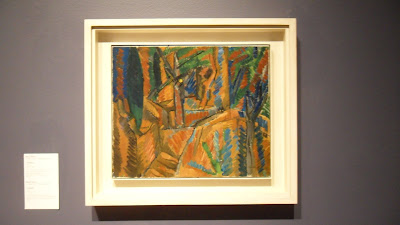
My first painting is a true Cubist era piece titled
L'Estaque done in 1913. It is an oil on canvas
by Raoul Dufy (Le Havre 1877 - Forcalquier 1953)
This painting is found on the main floor of the Museum in the Modern Art exhibit entitled
The Modern Tradition - from Monet to Picasso;
Selected Works from the Museum's Collection.
Dufy was a French painter who was educated at the École des Beaux-Arts in Paris.
Like many artists of the era he was fascinated with the works of both Vincent van Gogh and Paul Cezanne. He later worked side by side with Georges Braque in L'Estaque where they both painted Cubist style landscapes. In 1913 in the height of the movement Raoul Dufy had begun to develop his own personal style.
 Composition 40
Composition 40 is by Paul-Emile Borduas (Saint-Hilaire 1905 - Paris 1960). It is also oil on canvas and was done in 1958. It was a gift of Renee Borduas given to the Museum of Fine Arts.
 The Black Star
The Black Star is also a piece by Paul-Emile Borduas. Oil on cnavas done in 1957, this piece was a gift of Mr. and Mrs. Gerard Lortie.
Both of the Borduas pieces are found on the lower level of the Museum (S2) in the Marcel Elefant Family Gallery in the Contemporary Art section of the permanent collection. There is quite a number of pieces by Borduas in this room as he was quite an important figure in Canadian Art history.
Borduas apprenticed as a church painter and decorator and later in 1923 he attended the École des Beaux-Arts de Montréal. In 1937 Borduas began teaching at l'École du Meuble.
He became involved with the Contemporary Arts Society, and in January 1938 he was elected vice-president of the group. Borduas began painting again, inspired by his work with children who showed him their innate surrealism and automatic writing which brought the name "Automatists" for the group after his painting Automatisme 1.47.
Borduas wrote the manifesto
Refus Global (or "Global Refusal") in late 1947- early 1948 which advocated the separation of church and state in Quebec. Borduas was dismissed from l'École du Meuble for his involvement in this social critique as the Catholic Church still had wide influence.
Unable to find work or support himself with his art, Paul-Emile Borduas returned to Paris where he died in 1960 of a heart attack.
 ch has come to be viewed as cubist, although it is probably more correct to say it is composed of cubes
ch has come to be viewed as cubist, although it is probably more correct to say it is composed of cubes



















































